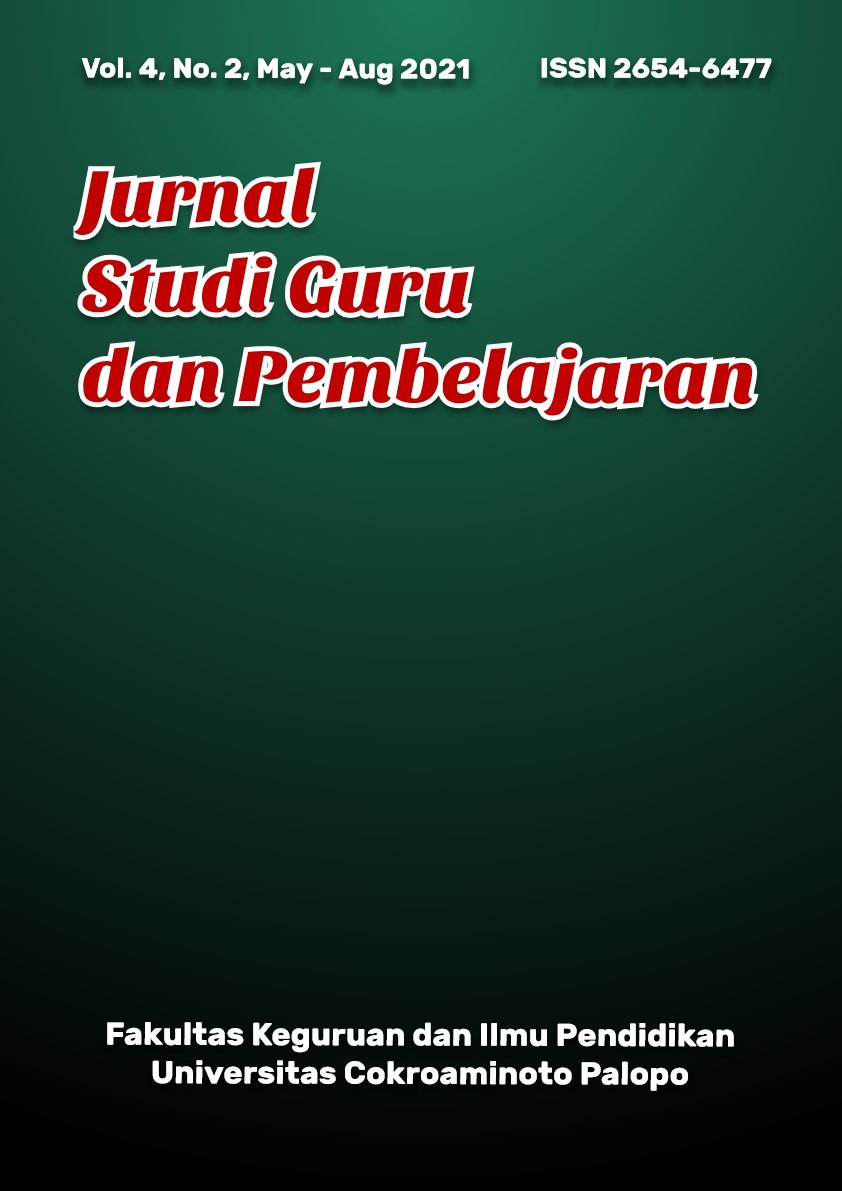Representasi Tipe Kecerdasan Majemuk pada Buku Teks Fisika SMP Kelas VIII
DOI:
https://doi.org/10.30605/jsgp.4.2.2021.1281Keywords:
Analisis Buku, Kecerdasan Majemuk, Buku TeksAbstract
Penelitian ini bertujuan untuk mengidentifikasi representasi kemunculan tipe-tipe kecerdasan majemuk pada buku teks Fisika SMP Kelas VIII. Pendekatan kuantitatif deskriptif digunakan dalam penelitian ini dengan metode analisis isi (content analysis). Sumber data berasal dari satu buku teks IPA Terpadu Kelas VIII (Penerbit: Erlangga Kurikulum 2013 Revisi). Karena buku IPA Terpadu mencakup semua mata pelajaran IPA, maka analisis buku dalam penelitian ini hanya dilakukan pada pokok bahasan fisika. Penelitian dilakukan dengan cara menganalisis buku teks menggunakan instrumen berupa daftar checklist yang merupakan hasil adaptasi dari penelitian Seyyed Ayatollah Razmjoo dan Zahra Jozaghi. Daftar checklist tersebut mengacu pada delapan tipe kecerdasan majemuk yang dirinci ke dalam beberapa aktivitas yang berkaitan dengan masing-masing tipe kecerdasan. Hasil penelitian menunjukkan bahwa buku teks IPA Terpadu (pokok bahasan Fisika) untuk SMP/MTs yang diterbitkan Erlangga belum mengakomodasi seluruh kecerdasan majemuk Gardner. Hal ini dikarenakan buku tersebut cenderung lebih fokus terhadap kecerdasan logika yang menekankan pada eksperimen, mengumpulkan data, berpikir, dan perhitungan
Downloads
References
Andronache, D., Bocos, M., & Raluca, B. (2011). The valences of multiple intelligences theory in optimizing the raining process. Journal of Educational Sciences/ Revista De Stiintele Educatiei, 13(2), 18-26.
Ardimen. (2016). Pengembangan Multiple Intelligencemelalui Pembelajaran Integratif Berbasis Games. Jurnal Edukasi, 2(2): 107-129. http://orcid.org/0000-0002-0731-688X DOI: https://doi.org/10.22373/je.v2i2.811
Astuti, K. A. W., Santyasa, I. W., Si, M., & Artawan, P. (2016). Pengembangan Model Pembelajaran Berbasis Kecerdasan Majemuk untuk Meningkatkan Pemahaman Konsep Fisika Siswa. Jurnal Pendidikan Fisika Undiksha, 3(1). http://dx.doi.org/10.23887/jjpf.v3i1.6871
Dewi, N. A. K., Aminah, N. S., & Sukarmin. (2015). Pengembangan Modul Fisika Berbasis Relating, Experiencing, Applying, Cooperating, And Transferring (REACT) Pada Materi Alat Optik Untuk Meningkatkan Kecerdasan Majemuk dan Kreativitas Siswa. Jurnal Inkuiri, 4(2), 47-56. https://doi.org/10.20961/inkuiri.v4i2.9558
Gardner, H. (1999). Intelligence reframed: Multiple intelligences for the 21st century. New York, NY: Basic Books.
Gardner, H., & Hatch, T. (1989). Educational implications of the theory of multiple intelligences. Educational Researcher, 18(8), 4–10. doi:10.3102/0013189X018008004 DOI: https://doi.org/10.3102/0013189X018008004
Hasnidar, H., Sulihin, S., & Elihami, E. (2020). Developing of Multiple Intelligences in students with the Two Stay Two Strays Type. Edumaspul: Jurnal Pendidikan, 4(2), 7-12. Retrieved from https://ummaspul.e-journal.id/maspuljr/article/view/680
Indria, A. (2020). Multiple Intelligence. Jurnal Kajian dan Pengembangan Umat, 3(1): 26-41. https://doi.org/10.31869/jkpu.v3i1.1968
Ketabi, S., Nasiri, M.& Dastjerdi, H. V. (2012). Multiple Intelligences in locally-published ELT textbooks in Iran. MJAL, 4(4), 258-266.
Omer, B. O. (2017). The Representation Of Multiple Intelligences In North Star Coursebook: A Content Analysis. Journal of University of Human Development, 3(3). https://doi.org/10.21928/juhd.v3n3y2017.pp590-594 DOI: https://doi.org/10.21928/juhd.20170820.25
Palupi dan Dadan. (2018). Analisis Kesesuaian Buku Siswa Mata Pelajaran Ilmu Pengetahuan Alam SMP Kurikulum 2013 Kelas VII Ditinjau Dari Standar Proses dan Penilaian Autentik. Jurnal Pendidikan IPA, 07(7), 373-378.
Razmjoo, S. A. & Jozaghi, Z. (2010). The Representation of Multiple Intelligences Types in the Top-Notch Series: A Textbook Evaluation. Pan- Pacific Association of Applied Linguistics, 14(2), 59-84.
Downloads
Published
How to Cite
Issue
Section
License
In submitting the manuscript to the journal, the authors certify that:
- They are authorized by their co-authors to enter into these arrangements.
- The work described has not been formally published before, except in the form of an abstract or as part of a published lecture, review, thesis, or overlay journal.
- That it is not under consideration for publication elsewhere,
- That its publication has been approved by all the author(s) and by the responsible authorities – tacitly or explicitly – of the institutes where the work has been carried out.
- They secure the right to reproduce any material that has already been published or copyrighted elsewhere.
- They agree to the following license and copyright agreement.
License and Copyright Agreement
Authors who publish with JSGP agree to the following terms:
- Authors retain copyright and grant the journal right of first publication with the work simultaneously licensed under Creative Commons Attribution License (CC BY-SA 4.0) that allows others to share the work with an acknowledgement of the work's authorship and initial publication in this journal.
- Authors are able to enter into separate, additional contractual arrangements for the non-exclusive distribution of the journal's published version of the work (e.g., post it to an institutional repository or publish it in a book), with an acknowledgement of its initial publication in this journal.
- Authors are permitted and encouraged to post their work online (e.g., in institutional repositories or on their website) prior to and during the submission process, as it can lead to productive exchanges, as well as earlier and greater citation of published work.














